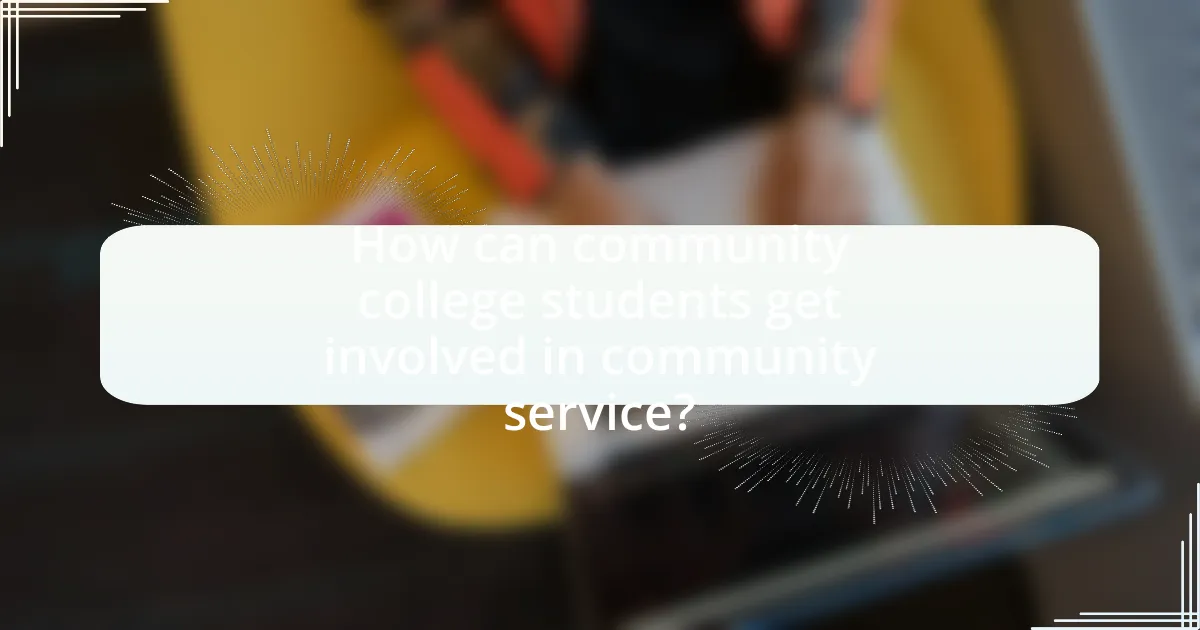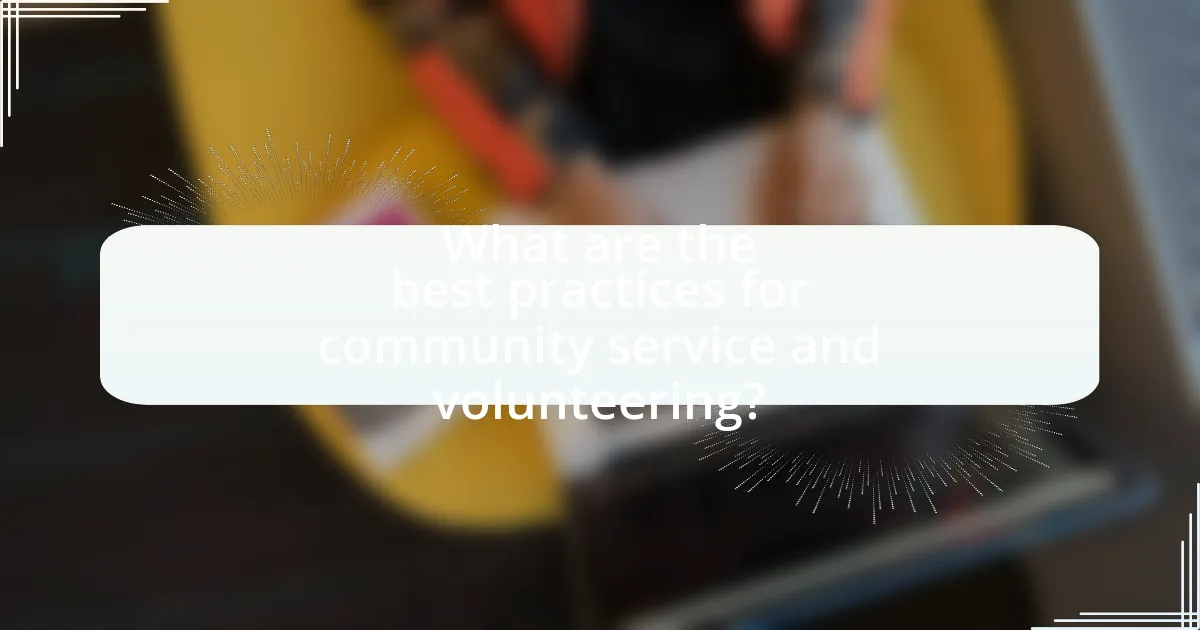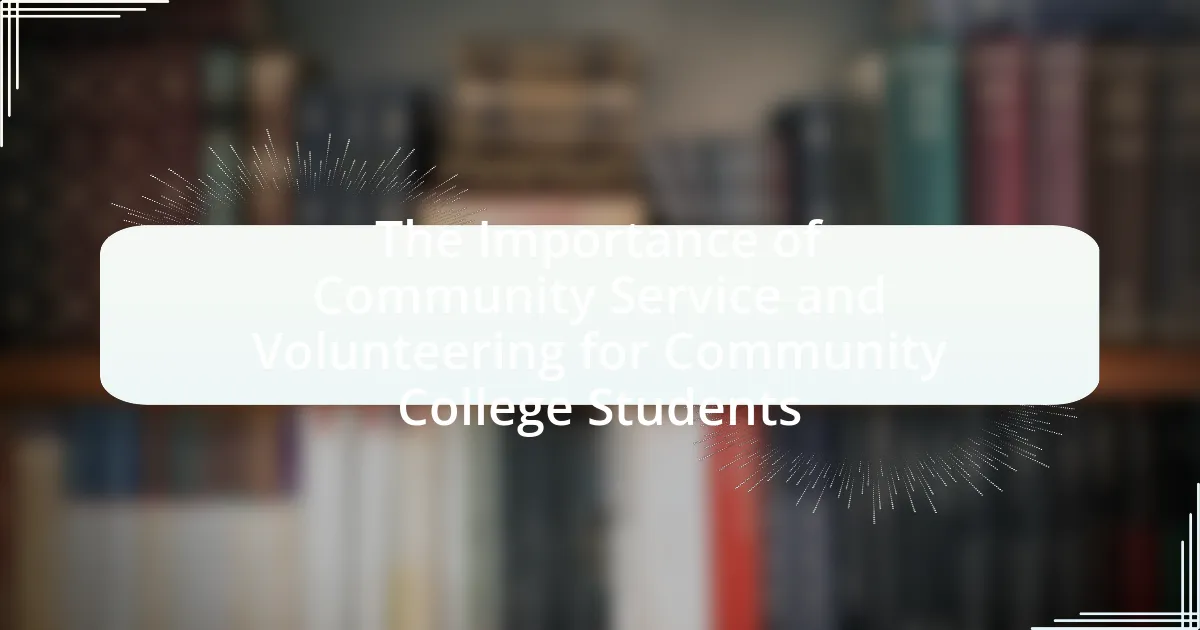The article focuses on the significance of community service and volunteering for community college students, highlighting how these activities contribute to personal development, social responsibility, and employability. It discusses the essential skills gained through volunteering, such as teamwork, leadership, and communication, which are highly valued in the job market. The article also emphasizes the academic benefits of community service, including improved graduation rates and academic performance, as well as the positive impact on mental health and social connections. Furthermore, it outlines various community service opportunities available to students, the barriers they may face, and strategies to effectively balance academics with volunteering. Overall, the article underscores the multifaceted advantages of community service for both students and their communities.

What is the importance of community service and volunteering for community college students?
Community service and volunteering are crucial for community college students as they enhance personal development, foster social responsibility, and improve employability. Engaging in these activities allows students to develop essential skills such as teamwork, leadership, and communication, which are highly valued in the job market. According to a study by the Corporation for National and Community Service, students who participate in service-learning programs have higher graduation rates and improved academic performance. Additionally, volunteering helps students build networks and connections within their communities, which can lead to job opportunities and professional growth.
Why should community college students engage in community service?
Community college students should engage in community service to enhance their personal development and career prospects. Participation in community service fosters essential skills such as teamwork, leadership, and communication, which are highly valued by employers. According to a study by the Corporation for National and Community Service, individuals who volunteer are 27% more likely to find a job after being out of work than those who do not engage in volunteer activities. Additionally, community service allows students to build networks and connections within their communities, further increasing their opportunities for internships and job placements.
What are the personal benefits of volunteering for students?
Volunteering provides students with significant personal benefits, including enhanced social skills, increased self-esteem, and improved mental health. Engaging in volunteer work allows students to interact with diverse groups, fostering communication and teamwork abilities. Research indicates that 87% of volunteers report feeling a sense of purpose and fulfillment, which contributes to higher self-esteem. Additionally, studies show that volunteering can reduce symptoms of depression and anxiety, promoting overall mental well-being. These benefits collectively support students’ personal growth and development, making volunteering a valuable experience.
How does community service enhance academic experiences?
Community service enhances academic experiences by providing practical applications of classroom knowledge, fostering critical thinking, and improving interpersonal skills. Engaging in community service allows students to apply theoretical concepts in real-world settings, which reinforces learning and enhances retention. Research indicates that students who participate in service-learning programs demonstrate higher academic performance, with a study by the National Service-Learning Clearinghouse showing that service-learning participants have improved grades and higher graduation rates compared to their peers. Additionally, community service cultivates essential soft skills such as teamwork, communication, and problem-solving, which are vital for academic success and future employment.
What role does community service play in student development?
Community service plays a crucial role in student development by fostering essential skills such as leadership, teamwork, and empathy. Engaging in community service allows students to apply academic knowledge in real-world settings, enhancing their problem-solving abilities and social awareness. Research indicates that students who participate in community service report higher levels of personal and social responsibility, as well as improved academic performance. For instance, a study published in the Journal of Higher Education found that students involved in service-learning programs had a 20% increase in retention rates compared to their peers who did not participate. This evidence underscores the significant impact of community service on both personal growth and academic success in students.
How does volunteering contribute to skill development?
Volunteering contributes to skill development by providing hands-on experience that enhances both soft and hard skills. Engaging in volunteer activities allows individuals to practice teamwork, communication, and problem-solving in real-world scenarios, which are essential skills in the workforce. For instance, a study published in the Journal of Community Engagement and Scholarship found that students who participated in volunteer programs reported improved leadership abilities and increased confidence in their skills. Additionally, volunteering often requires specific task-oriented skills, such as project management or technical skills, which further contribute to an individual’s professional growth.
In what ways does community service foster social connections?
Community service fosters social connections by bringing individuals together to work towards common goals, thereby enhancing interpersonal relationships. Engaging in community service activities allows participants to meet diverse groups of people, which can lead to the formation of friendships and networks. Research indicates that volunteering increases social interaction and community engagement, as evidenced by a study published in the Journal of Community Psychology, which found that individuals who volunteer report higher levels of social support and connectedness. Additionally, collaborative efforts in community projects encourage teamwork and communication, further solidifying social bonds among participants.
What impact does community service have on the community?
Community service significantly enhances the community by addressing local needs and fostering social cohesion. It provides essential support to various initiatives, such as food drives, educational programs, and environmental clean-ups, which directly improve the quality of life for residents. Research indicates that communities with active volunteer programs experience lower crime rates and increased civic engagement, as noted in a study by the Corporation for National and Community Service, which found that volunteering can lead to a 10% increase in community trust and cooperation. This collaborative effort not only meets immediate needs but also builds a sense of belonging and responsibility among community members, ultimately leading to a more resilient and connected society.
How does volunteering address community needs?
Volunteering addresses community needs by providing essential services and support that may otherwise be lacking. For instance, volunteers often fill gaps in areas such as education, healthcare, and social services, helping to improve the overall quality of life in their communities. According to a report by the Corporation for National and Community Service, volunteers contributed approximately 6.9 billion hours of service in 2017, valued at over $167 billion, demonstrating the significant impact of volunteer efforts on community development and resource availability.
What are the long-term benefits of community service for local organizations?
Community service provides long-term benefits for local organizations by enhancing their capacity to serve the community effectively. Engaging volunteers through community service initiatives leads to increased manpower, which allows organizations to expand their programs and reach more individuals in need. For instance, a study by the Corporation for National and Community Service found that organizations with volunteers reported a 20% increase in service delivery capabilities. Additionally, community service fosters stronger relationships between organizations and the communities they serve, resulting in improved trust and collaboration. This relationship-building can lead to sustained support, both in terms of funding and community engagement, which is crucial for the long-term viability of local organizations.

How can community college students get involved in community service?
Community college students can get involved in community service by participating in local volunteer programs, joining campus organizations focused on service, and engaging in service-learning courses that integrate community work with academic study. Many community colleges have partnerships with local nonprofits and organizations that provide structured opportunities for students to volunteer, such as food banks, shelters, and environmental clean-up initiatives. Additionally, students can seek out internships or service projects that align with their academic interests, which not only contribute to the community but also enhance their resumes and skill sets. According to the Corporation for National and Community Service, students who engage in community service report higher levels of academic success and personal development, highlighting the benefits of such involvement.
What types of community service opportunities are available?
Community service opportunities include volunteering at local shelters, participating in environmental clean-up projects, tutoring students, assisting in food banks, and engaging in community health initiatives. These activities allow individuals to contribute positively to their communities while gaining valuable experience. For instance, according to the Corporation for National and Community Service, over 64 million Americans volunteered in 2019, demonstrating the widespread availability and impact of such opportunities.
How can students find local volunteering opportunities?
Students can find local volunteering opportunities by utilizing online platforms, community bulletin boards, and local nonprofit organizations. Websites like VolunteerMatch and Idealist allow students to search for volunteer positions based on their location and interests. Additionally, community centers and libraries often post volunteer opportunities on bulletin boards, while local nonprofits frequently have their own websites listing available positions. According to a 2021 report by the Corporation for National and Community Service, approximately 25% of young adults engage in volunteer work, highlighting the accessibility and importance of these opportunities for students.
What are some examples of impactful community service projects?
Examples of impactful community service projects include food drives, tutoring programs, and environmental clean-up initiatives. Food drives, such as those organized by local food banks, help alleviate hunger in communities by collecting non-perishable items and distributing them to families in need. Tutoring programs, often run by community colleges, provide academic support to underprivileged students, improving their educational outcomes and fostering a culture of learning. Environmental clean-up initiatives, like beach or park clean-ups, not only beautify public spaces but also raise awareness about environmental issues, promoting sustainability. These projects demonstrate the significant positive effects community service can have on both individuals and the broader community.
What are the barriers to volunteering for community college students?
Community college students face several barriers to volunteering, including time constraints, financial limitations, and lack of awareness about opportunities. Time constraints arise from balancing academic responsibilities, work commitments, and family obligations, making it difficult for students to dedicate time to volunteer activities. Financial limitations can restrict students from participating in unpaid volunteer work, as they may need to prioritize paid employment to support their education and living expenses. Additionally, a lack of awareness about available volunteer opportunities can prevent students from engaging in community service, as they may not know where to find information or how to get involved. These barriers collectively hinder community college students from fully participating in volunteer activities that could enhance their educational experience and community engagement.
How can students overcome time constraints to participate in community service?
Students can overcome time constraints to participate in community service by prioritizing their schedules and integrating service activities into their existing commitments. By assessing their time management skills, students can identify blocks of time that can be allocated to community service, such as weekends or breaks between classes. Research indicates that students who engage in structured time management techniques, such as the Pomodoro Technique or time-blocking, report higher levels of productivity and satisfaction, allowing them to balance academics and service effectively. Additionally, forming partnerships with community organizations that offer flexible volunteering opportunities can further facilitate participation, as these organizations often accommodate students’ schedules.
What resources are available to support student volunteers?
Student volunteers can access various resources to enhance their volunteering experience, including training programs, mentorship opportunities, and community service organizations. Training programs often provide essential skills and knowledge relevant to specific volunteer roles, while mentorship opportunities connect students with experienced volunteers who can offer guidance and support. Community service organizations, such as local nonprofits and volunteer centers, frequently offer resources like volunteer databases, project funding, and networking events to facilitate student engagement in community service. These resources collectively empower student volunteers to make a meaningful impact in their communities.

What are the best practices for community service and volunteering?
The best practices for community service and volunteering include selecting a cause that aligns with personal interests, committing to regular participation, and collaborating with established organizations. Engaging in a cause that resonates personally enhances motivation and fulfillment, while consistent involvement fosters deeper connections and a greater impact. Collaborating with reputable organizations ensures that efforts are effective and that volunteers receive proper guidance and support. Research indicates that structured volunteer programs can lead to improved community outcomes, as seen in studies by the Corporation for National and Community Service, which highlight the positive effects of organized volunteerism on both communities and volunteers.
How can students maximize their community service experience?
Students can maximize their community service experience by actively engaging in projects that align with their interests and skills. When students choose service opportunities that resonate with their passions, they are more likely to remain committed and motivated, leading to a more impactful experience. Research indicates that individuals who are personally invested in their volunteer work report higher satisfaction and a greater sense of accomplishment (Bussell & Forbes, 2009). Additionally, students should seek leadership roles within their service projects, as taking on responsibilities enhances personal growth and skill development. According to a study by the Corporation for National and Community Service, students who lead community service initiatives develop stronger leadership skills and a deeper understanding of community needs. By reflecting on their experiences and seeking feedback, students can also identify areas for improvement, further enriching their community service journey.
What strategies can enhance the effectiveness of volunteering efforts?
To enhance the effectiveness of volunteering efforts, organizations should implement structured training programs for volunteers. Structured training equips volunteers with the necessary skills and knowledge to perform their tasks efficiently, leading to improved service delivery. Research indicates that organizations with comprehensive training programs report a 50% increase in volunteer retention rates, which directly correlates with the effectiveness of their initiatives. Additionally, establishing clear goals and measurable outcomes for volunteer projects ensures that efforts are aligned with community needs, further enhancing impact.
How can students reflect on their community service experiences for personal growth?
Students can reflect on their community service experiences for personal growth by engaging in structured reflection activities such as journaling, group discussions, and self-assessment. These activities allow students to critically analyze their experiences, identify personal values, and recognize the skills they have developed. Research indicates that reflective practices enhance learning outcomes; for instance, a study published in the Journal of Higher Education found that students who engaged in reflective writing reported increased self-awareness and a deeper understanding of their community’s needs. By systematically reflecting on their service experiences, students can connect their actions to personal development and future goals.
What tips can help students balance academics and volunteering?
To balance academics and volunteering, students should prioritize effective time management. By creating a structured schedule that allocates specific time blocks for studying and volunteering, students can ensure that neither responsibility is neglected. Research indicates that students who engage in structured time management report higher academic performance and lower stress levels (Britton & Tesser, 1991). Additionally, setting clear goals for both academic and volunteer activities helps maintain focus and motivation, allowing students to track their progress and adjust their commitments as needed.
How can time management improve the volunteering experience for students?
Time management can significantly enhance the volunteering experience for students by allowing them to allocate sufficient time for both their academic responsibilities and community service activities. Effective time management enables students to prioritize tasks, ensuring they can engage meaningfully in volunteer work without compromising their studies. Research indicates that students who practice good time management report higher levels of satisfaction and lower stress, which can lead to a more fulfilling volunteering experience. For instance, a study published in the Journal of Educational Psychology found that students who effectively manage their time are more likely to participate in extracurricular activities, including volunteering, which enriches their overall educational experience.
What are the benefits of setting volunteering goals for personal development?
Setting volunteering goals for personal development enhances skills, builds networks, and fosters self-awareness. By establishing specific objectives, individuals can focus on acquiring competencies such as leadership, communication, and teamwork, which are essential in both personal and professional contexts. Research indicates that volunteering can lead to increased self-esteem and life satisfaction, as evidenced by a study published in the Journal of Happiness Studies, which found that individuals who volunteer regularly report higher levels of happiness and fulfillment. Additionally, volunteering provides opportunities to connect with diverse groups, expanding social networks and enhancing cultural competence, which are valuable in today’s interconnected world.

Leave a Reply